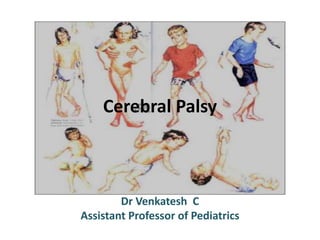Cerebral palsy
•Descargar como PPTX, PDF•
10 recomendaciones•3,505 vistas
Denunciar
Compartir
Denunciar
Compartir

Recomendados
Recomendados
Más contenido relacionado
La actualidad más candente
La actualidad más candente (20)
Destacado
Event: Falls Prevention and Home Safety for the Elderly
Date: 15 February 2014
Venue: AICare Hub
Presentation: Preventing Falls Among Elderly
by Mr Alan Ong, Mr Senthil Kumar & Miss Nurul Atiqah (Occupational/Physio-therapists, Society for the Physically Disabled)
What are the common causes of fall, and what to do when a fall occurs? How to make your home safer?
Event @ AICare Hub (15 Feb) - Falls Prevention and Home Safety for the Elderly

Event @ AICare Hub (15 Feb) - Falls Prevention and Home Safety for the ElderlySingapore Silver Pages
Destacado (20)
Zen and the Art of Raising a Child with Cerebral Palsy

Zen and the Art of Raising a Child with Cerebral Palsy
Event @ AICare Hub (15 Feb) - Falls Prevention and Home Safety for the Elderly

Event @ AICare Hub (15 Feb) - Falls Prevention and Home Safety for the Elderly
Similar a Cerebral palsy
Similar a Cerebral palsy (20)
cerebral palsy Rare disease. and Rural Good Health action

cerebral palsy Rare disease. and Rural Good Health action
Cerebral palsy for MBBS (undergraduate medical teaching)

Cerebral palsy for MBBS (undergraduate medical teaching)
Cerebral palsy
- 1. Cerebral Palsy Dr Venkatesh C Assistant Professor of Pediatrics
- 2. Introduction • Major cause of disability in children • Incidence 1 in 500 births • 70-80% are due to prenatal factors • No known cure, Prevention is the key.
- 4. Postnatal Brain Growth • Brain growth continues postnatally well into adolescence • More than 90% Brain growth is complete by 2 years • As age advances, myelination increases with pruning of synapses
- 5. Definition • Disorder of movement and posture • Non-progressive insult • growing brain • Dynamic manifestations
- 6. Aetiology • Antenatal- Extreme prematurity, Multiple gestation, IEM, Genetic diseases, Brain malformation, Congenital infection, maternal toxemia, placental abnormalities, coagulopathy, Heamorrhage • Birth- Low birth weight, MSL, Infection, trauma, Kernicterus • Postnatal- infection, trauma, toxins
- 7. Pathology
- 8. Pathology
- 9. Pathology
- 10. Pathology
- 11. Types • Spastic • Dyskinetic • Hypotonic/ataxic • Mixed
- 12. Spastic CP • 70-80% of CP • Increased muscle tone- clasp knife type • Increased reflexes, clonus, contractures • Scissoring and toe walking • Difficulty changing diapers • Seizures & mental retardation • Feeding difficulty
- 13. Types based on limb involvement
- 14. Hyperkinetic/athetoid • 10-20% of CP • Involuntary movements of hands, feet, arms, muscles of face/tongue • Movements increased by stress, decreased by sleep • Mental retardation
- 15. Hypotonic/ataxic • Least common type • Floppy infant • Poor coordination • Unsteady gait • Difficulty in performing rapid movements
- 16. Mixed • Combination of above • Spastic and athetoid most common • Hypotonic and athetoid • Variable frequency of seizures, MR
- 18. Early markers • Persistent fisting/ cortical thumb • Persistent primitive reflexes • Irritability • Delayed development • Early hand preference
- 19. Asymmetric tonic neck reflex
- 20. Diagnosis • Good history and physical examination • Neuroimaging CT/MRI • IU infection screen • Metabolic & genetic testing • Coagulation studies • Screening for co-morbidity – vision, hearing, seizures
- 21. Treatment • Multi-disciplinary approach • Early stimulation • Monitoring growth, nutrition • Vision and hearing assessment • Control of seizures • Reduce spasticity and contractures • Promote self care
- 22. Prognosis • No head control by age 1- unlikely to walk • Not sitting by 4 yrs- 99% will not walk • Sits unsupported by 2 yrs- 100% will walk
- 23. Prevention • Proper antenatal care and fetal monitoring • Hypothermia • Magnesium sulphate
